Preparing soda syrup involves a precise combination of water, sugar, and flavoring agents to create a concentrated mixture that can be blended with carbonated water. Achieving the right ingredient ratios is crucial, typically starting with a 1:1 water-to-sugar ratio and incorporating flavoring at 5-10% of the total volume. The extraction methods used for flavoring play a significant role in determining the syrup’s taste and quality, making attention to detail essential for a successful beverage.
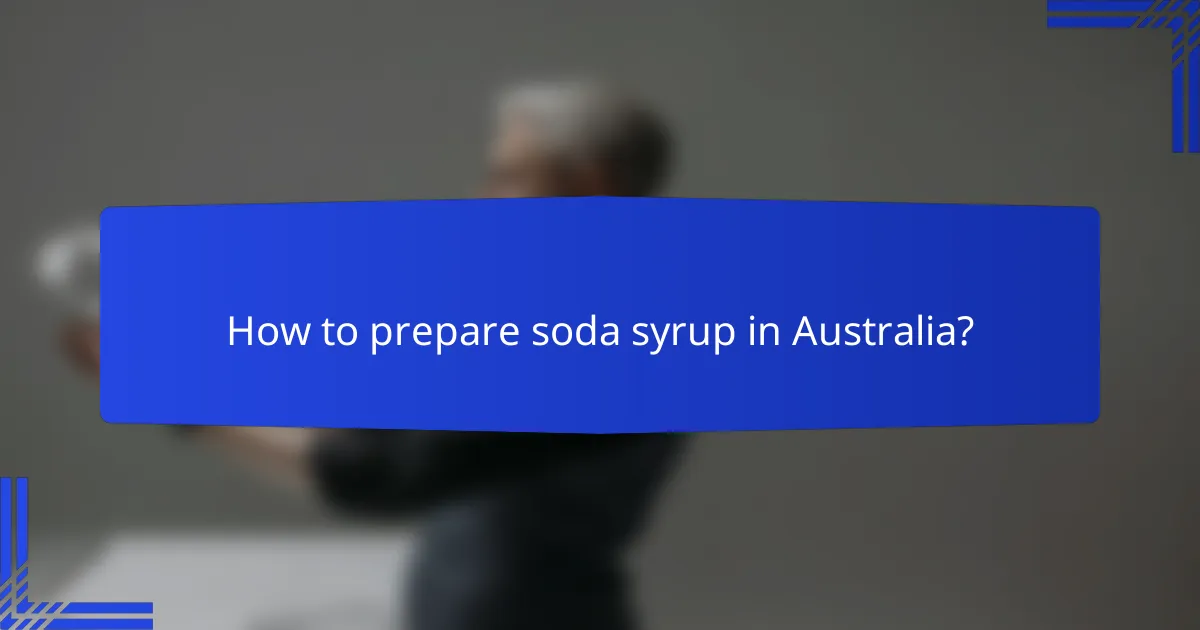
How to prepare soda syrup in Australia?
Preparing soda syrup in Australia involves combining water, sugar, and flavoring agents to create a concentrated syrup that can be mixed with carbonated water. The process requires careful attention to ingredient ratios, flavor extraction methods, and consistency factors to achieve the desired taste and texture.
Basic ingredient ratios
The standard ratio for soda syrup typically consists of one part sugar to one part water, though this can vary based on the desired sweetness and flavor intensity. For a more concentrated syrup, a ratio of 2:1 sugar to water is common, while lighter syrups may use a 1:2 ratio.
When adding flavoring agents, such as fruit extracts or herbs, start with approximately 10-20% of the total syrup volume. Adjust these ratios based on personal preference and the strength of the flavoring used.
Common flavor extraction methods
Flavor extraction can be achieved through several methods, including steeping, boiling, or cold infusion. Steeping involves soaking flavoring agents in hot water for a period, allowing the flavors to infuse into the liquid.
Boiling is effective for extracting flavors quickly but can alter the taste profile if done excessively. Cold infusion is a gentler method, ideal for delicate flavors, where the ingredients are left to steep in cold water for several hours or overnight.
Consistency factors
Consistency in soda syrup is influenced by the sugar concentration and the method of preparation. Higher sugar content results in a thicker syrup, while lower concentrations yield a more fluid consistency. Aim for a syrup that flows easily but is not overly runny.
Temperature also plays a role; warmer syrups tend to be less viscous. Ensure that the syrup cools to room temperature before bottling to maintain the desired consistency. Regularly check the syrup’s texture during preparation to make adjustments as needed.
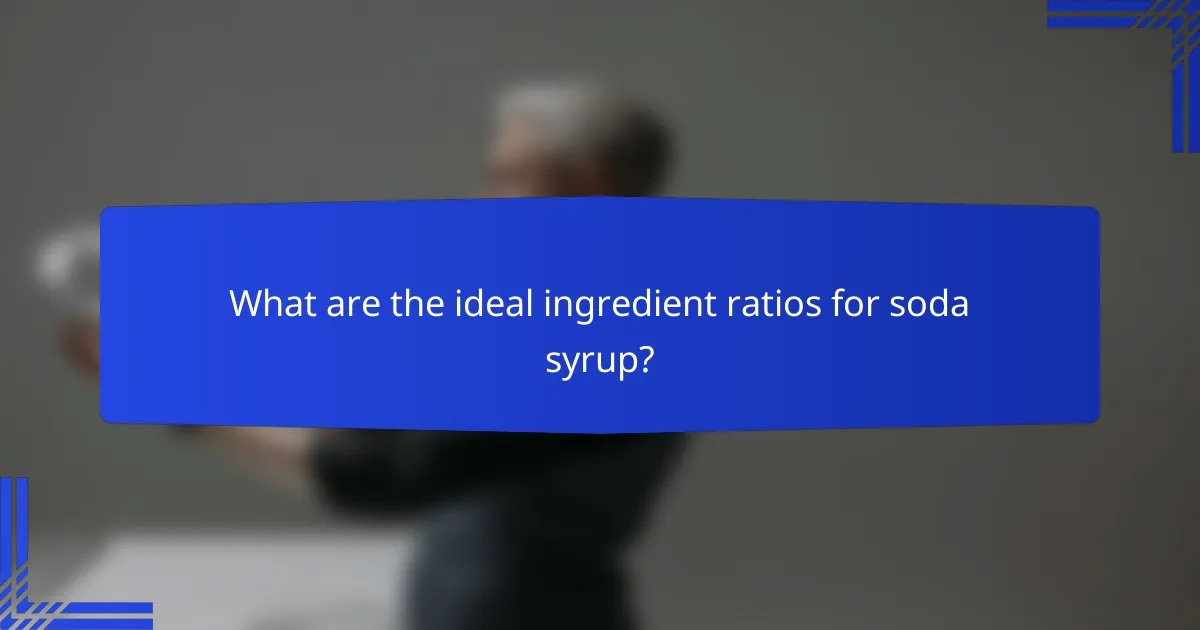
What are the ideal ingredient ratios for soda syrup?
The ideal ingredient ratios for soda syrup typically involve a balance of water, sugar, and flavoring to create a consistent and enjoyable beverage. A common starting point is a water-to-sugar ratio of about 1:1, with flavoring making up around 5-10% of the total mixture, but these can vary based on personal taste and desired sweetness.
Water to sugar ratio
The water to sugar ratio is crucial for achieving the right sweetness and mouthfeel in soda syrup. A standard ratio is 1:1, meaning equal parts water and sugar by weight, but some recipes may call for a slightly higher sugar content to enhance sweetness or improve preservation. For example, a 2:1 ratio (two parts sugar to one part water) can create a richer syrup.
When preparing soda syrup, consider the type of sugar used, as different sugars (like cane sugar, corn syrup, or agave) can affect the final flavor and consistency. Always dissolve the sugar completely in the water to avoid graininess in the syrup.
Flavoring concentration
Flavoring concentration is key to creating a distinctive soda syrup. Generally, flavoring should comprise about 5-10% of the total syrup volume, depending on the intensity of the flavor and personal preference. For instance, stronger extracts or essences may require less volume compared to lighter, more delicate flavors.
When adding flavoring, start with a small amount and gradually increase until the desired taste is achieved. This approach helps prevent overpowering the syrup with flavor and allows for adjustments based on the final beverage’s profile. Always keep in mind that flavors can intensify over time, so taste testing is essential during the preparation process.
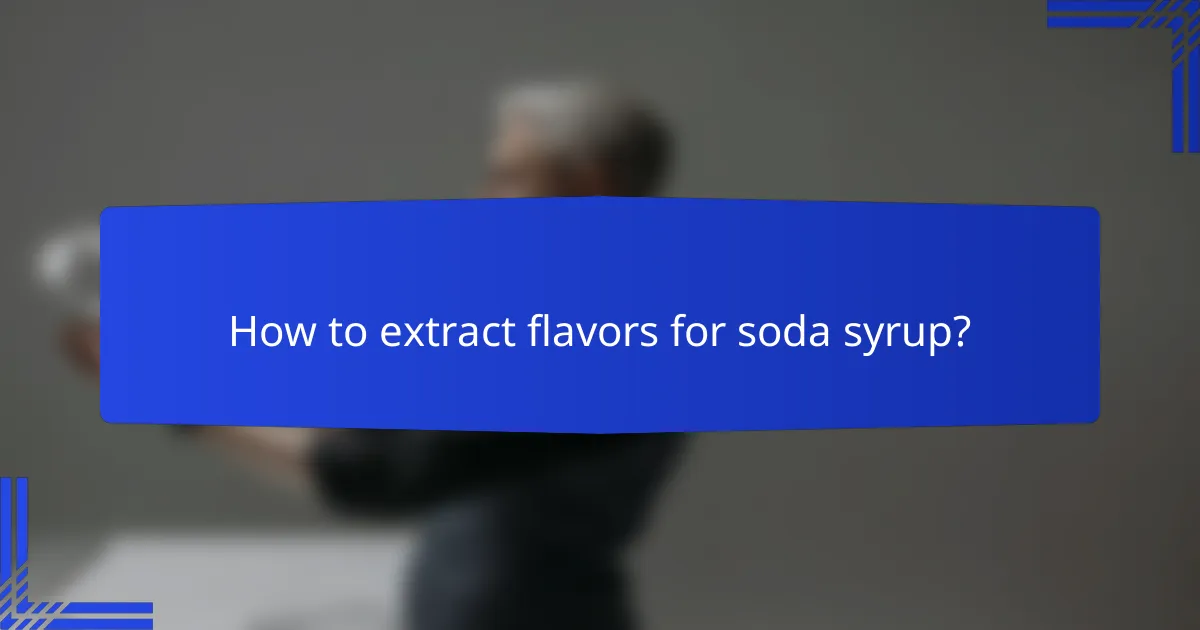
How to extract flavors for soda syrup?
Extracting flavors for soda syrup involves using various methods to capture the essence of ingredients, creating a concentrated flavor profile. The choice of extraction technique can significantly affect the taste, aroma, and overall quality of the syrup.
Using natural extracts
Natural extracts are derived from fruits, herbs, and spices, providing authentic flavors for soda syrups. Common options include vanilla, mint, and citrus extracts, which can be used in ratios of about 1-2 teaspoons per cup of syrup base, depending on the desired intensity.
When using natural extracts, ensure they are of high quality and free from artificial additives. This not only enhances flavor but also aligns with consumer preferences for natural ingredients.
Infusion techniques
Infusion techniques involve steeping ingredients in a liquid to extract their flavors. For instance, you can simmer herbs or spices in water or sugar syrup for 15-30 minutes, allowing the flavors to meld before straining the mixture.
Consider using cold infusion for delicate flavors, such as flowers or citrus peels, by letting them steep in cold syrup for several hours or overnight. This method preserves the subtle notes that might be lost in heat extraction.
Commercial flavoring options
Commercial flavoring options provide convenience and consistency for soda syrup production. These can include concentrated flavoring syrups or flavoring powders, which are often formulated to meet industry standards.
When selecting commercial flavorings, check for ingredient transparency and avoid those with excessive artificial components. A typical usage rate might range from 1-3 ounces of flavoring per gallon of syrup, depending on the product’s strength and your flavor preference.
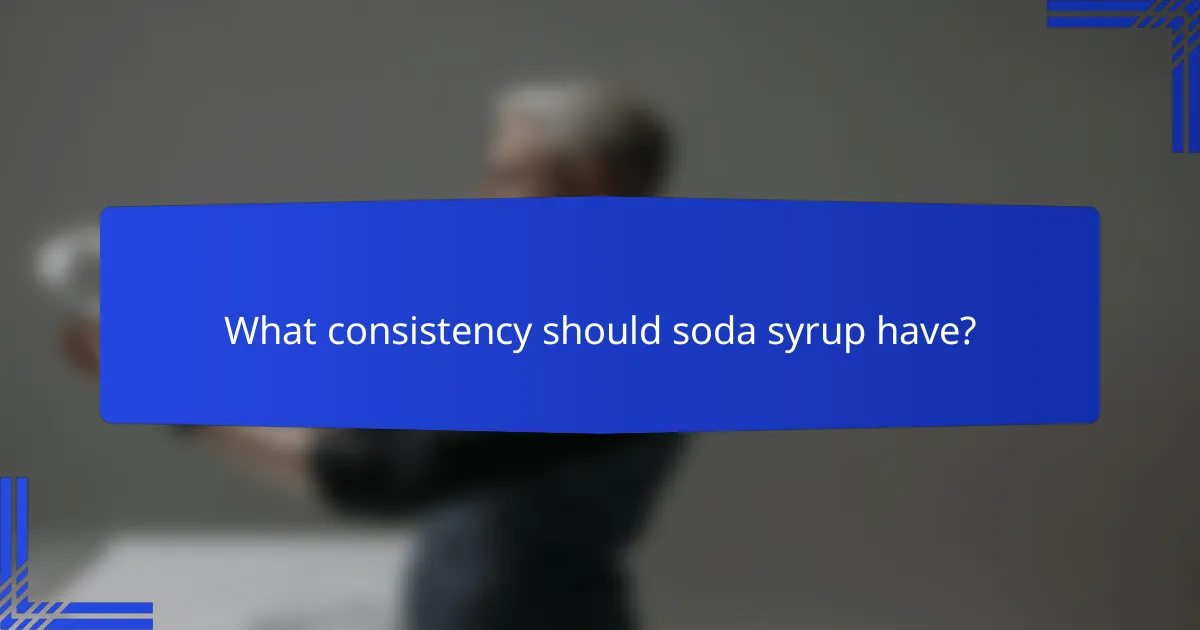
What consistency should soda syrup have?
Soda syrup should have a thick, viscous consistency that allows it to blend well with carbonated water while maintaining flavor intensity. The ideal syrup is typically syrupy but not overly sticky, ensuring smooth pouring and mixing.
Viscosity standards
The viscosity of soda syrup is generally measured in centipoise (cP), with most commercial syrups falling within a range of 100 to 300 cP. This thickness ensures that the syrup adheres well to the carbonation and enhances the overall mouthfeel of the beverage. For home preparation, achieving a similar consistency can be done by adjusting the sugar concentration and water content.
To maintain quality, consider using a refractometer to measure sugar content, aiming for a brix level of around 60-70%. This level provides a good balance between sweetness and syrup thickness.
Impact of temperature on consistency
Temperature significantly affects the consistency of soda syrup. As the temperature increases, syrup viscosity decreases, making it thinner and easier to pour. Conversely, cooling the syrup will thicken it, which can be useful in certain applications where a denser syrup is desired.
When preparing soda syrup, aim to work at room temperature for optimal mixing. If the syrup is too thick, gently warming it can help achieve the desired consistency without compromising flavor. Avoid overheating, as excessive heat can alter the flavor profile and degrade the syrup’s quality.

What equipment is needed for soda syrup preparation?
Preparing soda syrup requires specific equipment to ensure proper mixing, flavor extraction, and consistency. Essential tools range from simple kitchen items for home preparation to more advanced machinery for commercial use.
Essential tools for home preparation
For home soda syrup preparation, you will need a few basic tools. A saucepan is crucial for heating water and dissolving sugar, while a measuring cup ensures accurate ingredient ratios. A fine mesh strainer is useful for filtering out solids after flavor extraction.
Additionally, a whisk or spoon helps mix the ingredients thoroughly. If you want to experiment with flavors, consider using a food processor or blender to extract essences from fruits or herbs effectively.
Commercial equipment options
In a commercial setting, soda syrup preparation often involves more specialized equipment. A commercial-grade syrup mixer can streamline the process, allowing for larger batches and consistent flavor profiles. These machines typically feature precise temperature controls and automated mixing capabilities.
Other useful equipment includes a carbonation system, which infuses the syrup with carbon dioxide, and storage tanks for maintaining freshness. Investing in high-quality equipment can significantly enhance production efficiency and product quality.
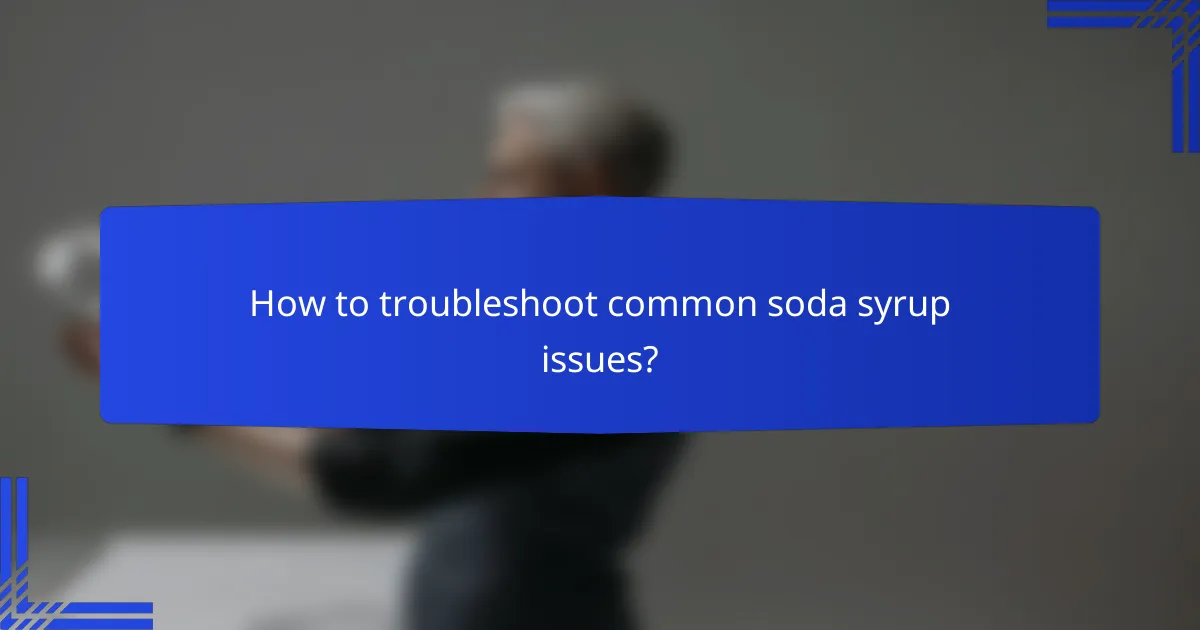
How to troubleshoot common soda syrup issues?
To troubleshoot common soda syrup issues, identify the specific problem, such as sweetness or flavor imbalance, and apply targeted solutions. Adjusting ingredient ratios and extraction methods can help achieve the desired consistency and taste.
Overly sweet syrup solutions
If your soda syrup is overly sweet, consider reducing the sugar content or increasing the acidity. A common approach is to add a small amount of citric acid or lemon juice, which can balance sweetness effectively.
Another option is to dilute the syrup with water or soda water. Start with a ratio of one part syrup to two parts water and adjust based on taste. This method maintains flavor while reducing sweetness.
Flavor imbalance fixes
For flavor imbalances, analyze the dominant flavors in your syrup. If one flavor is overpowering, try adding complementary flavors to create balance. For example, if the citrus flavor is too strong, a hint of vanilla can round it out.
Additionally, consider the extraction process. If using herbs or spices, ensure they are not steeped for too long, as this can lead to bitterness. A steeping time of 10-15 minutes is often sufficient for optimal flavor extraction.

What are the trends in soda syrup preparation?
Current trends in soda syrup preparation emphasize the use of natural ingredients, innovative flavor extraction methods, and achieving consistent product quality. As consumers increasingly seek healthier options, many producers are focusing on organic components and reducing artificial additives.
Ingredient Ratios
Ingredient ratios are crucial in soda syrup preparation, as they directly affect flavor intensity and sweetness. A common starting point is a ratio of 1 part syrup to 5 parts carbonated water, but this can vary based on the desired sweetness and flavor profile.
For example, a sweeter soda might require a higher syrup ratio, while a more subtle flavor could use less. Experimenting within a range of 1:4 to 1:6 can help achieve the perfect balance for different tastes.
Flavor Extraction
Flavor extraction techniques are evolving, with methods like cold pressing and steam distillation gaining popularity. Cold pressing preserves the freshness of fruits and herbs, while steam distillation can extract essential oils effectively, providing a more concentrated flavor.
Producers are also exploring the use of natural extracts and essences, which can enhance flavor without the need for artificial additives. This trend aligns with consumer preferences for transparency and natural ingredients.
Consistency
Maintaining consistency in soda syrup is essential for brand reliability. This involves careful monitoring of ingredient quality and precise measurements during preparation. Using standardized recipes and batch testing can help ensure that each batch meets the same flavor profile.
Additionally, employing automated systems for mixing and measuring can reduce human error and improve overall consistency. Regular quality checks are recommended to maintain standards and address any variations that may arise during production.
